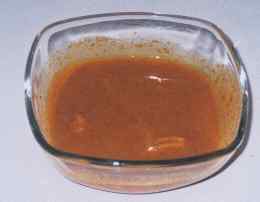Amba (condiment) facts for kids
 |
|
| Alternative names | Amba sauce |
|---|---|
| Type | Condiment, spread or dip |
| Place of origin | Iraq, India |
| Region or state | India, Pakistan, Iraq, Israel, and Saudi Arabia |
| Main ingredients | Pickled mango |
Amba is a super tasty, tangy sauce made from pickled green mangoes. It's a bit like a spicy mango jam! People usually make it with green mangoes, vinegar, salt, a yellow spice called turmeric, chili peppers, and fenugreek. It first came from India, brought by Jewish communities.
Contents
Where the Name Amba Comes From
Since mangoes come from South Asia, the name 'Amba' likely comes from the Marathi word āmbā. This word itself comes from an even older language, Sanskrit, where 'āmra' means 'mango'.
The Story of Amba
People say Amba was first made in the 1800s by the Sassoon family in Bombay, India. They were a Jewish family from Baghdad. Later, in the 1950s, Jewish people who moved from Iraq brought Amba to Israel. They often ate it with their special Shabbat morning meal.
Different Ways Amba is Used
In Iraqi Food
In Iraqi cuisine, Amba is a popular spicy sauce. People often add it to fish dishes, falafel, kubbah, kebabs, and eggs.
In Saudi Arabian Food
Amba is also very popular in the Arabian Peninsula. You can buy it in sealed jars or by the kilo. People eat it with bread as part of a meal called nawashef. This meal is a mix of small plates with different foods like cheese, egg dishes, pickles, ful mudammas, falafel, and mutabbag. It's often eaten for breakfast or dinner.
In Indian Food
Amba is similar to a type of South Asian pickle called achar in India.
In Jewish Food
Amba is a well-known dish in Sephardic Jewish cuisine and Mizrahi Jewish cuisine. It became very popular in Israel after Iraqi Jews brought it there in the 1950s and 1960s. Today, it's one of the most common sauces in Israel!
Israeli Amba is special because it's always made with unripe, green mangoes. This makes it taste less sweet and more savory. It's often used as a topping on shawarma sandwiches, falafels, and especially on sabikh sandwiches. You can also add it to meorav yerushalmi, kebabs, and salads.
Amba in Books
Amba is even mentioned in books, especially in stories about people's lives. For example, in his book Baghdad Yesterday, Sasson Somekh wrote a whole chapter about Amba. He used the story of Amba to talk about the history of the Iraqi Jewish community.
Another writer, Khalid Qisthini, wrote an article remembering the foods of Baghdad from the past. His article was called "Talking about the food of amba and samoon, which characterised Baghdad of the past." He remembered how, as a child, students would rush out of school to buy samoon (a type of bread) with Amba from street sellers. If the seller was generous, they would add a little extra Amba!
See also
 In Spanish: Amba (encurtido) para niños
In Spanish: Amba (encurtido) para niños

